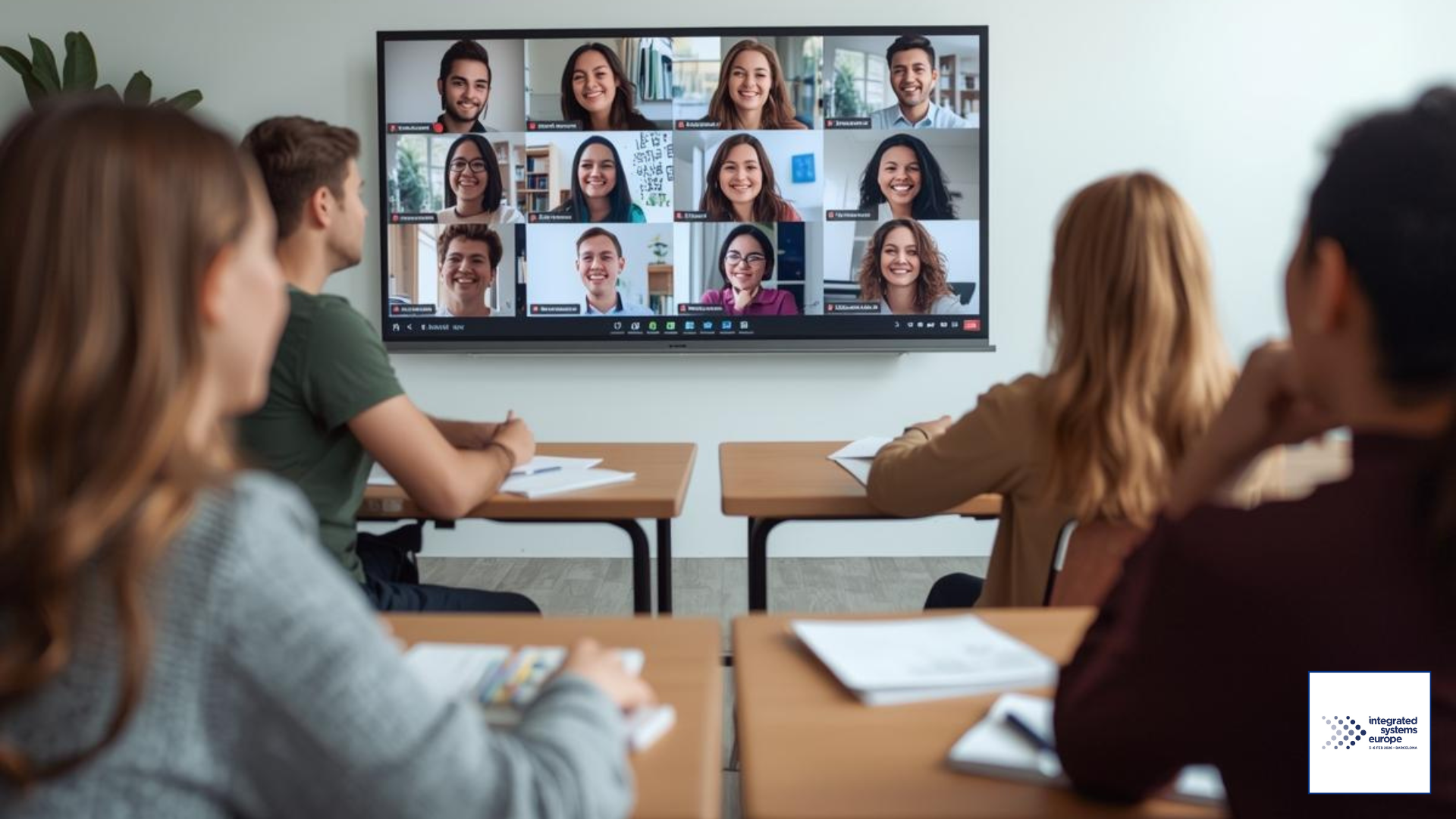My Take: Bridging the AV/IT Gap: Deploying and Supporting Microsoft Teams Rooms in Higher Education
By Marc Cholewczynski and Raul Burriel
Introduction
The rapid shift toward hybrid learning, remote work coordination, and engaging collaboration has accelerated the need for standardized meeting and instructional spaces in higher education. Microsoft Teams Rooms (MTRs) have emerged as an intriguing option offering the promise of ease of use, seamless video conferencing, content sharing, AI enablement, and meeting automation within Microsoft’s ecosystem. However, for traditional AV teams accustomed to DSPs, matrix switchers, AVoIP transport, and proprietary control systems, integrating MTRs can feel like stepping into IT-centric territory.
This shift presents several challenges: navigating Microsoft’s licensing model, understanding Teams resource accounts, and bridging the gap between AV and IT workflows. AV professionals must expand their knowledge beyond traditional audiovisual systems and embrace new tools for device management, network configuration, and security protocols. This article provides a practical roadmap and shared experience for learning, deploying, and supporting MTRs in a higher education enterprise environment, while addressing the common hurdles or speed bumps that AV teams may face along the way.
The Ask: Why would Higher Ed want to adopt Microsoft Teams Rooms in the first place?
Universities may find themselves intrigued and curious with MTRs to streamline collaboration, reduce technical complexity, ensure consistency across campus meeting spaces, and unlock the potential of providing a front door to access AI in large group and classroom presentation spaces. Several factors are driving this shift:
- Standardization Across Campuses – Many universities are interested in consolidating meeting platforms to simplify support, reducing the number of disparate conferencing solutions (Zoom, Webex, Google Meet) in favor of products like Microsoft Teams.
- IT-Led Collaboration Strategies – Universities are aligning AV deployments with IT policies, prioritizing security, device management, and integration with enterprise platforms like Microsoft 365.
- Simplified User Experience – Faculty and staff expect intuitive, one-touch meeting experiences, and MTRs can potentially deliver that without requiring extensive training.
To achieve these goals, AV and IT teams must align their workflows, ensuring that MTR deployments meet both technology and pedagogical needs while maintaining seamless integration with existing AV systems.
Embracing the Uncertainty: The AV Learning Curve
For AV professionals, moving from Crestron, Extron, QSYS, and Biamp environments to Microsoft Teams Rooms can feel like entering uncharted territory. Instead of focusing on signal flow diagrams and control programming, AV teams must learn and become familiar with:
- Microsoft Entra ID (formerly Azure AD) and Licensing – Understanding MTR resource accounts, authentication, and Teams licensing models.
- Device Management – Shifting from proprietary AV control systems to Microsoft Teams Admin Center (TAC) and Intune for remote monitoring.
- Network Considerations – Ensuring QoS for Teams traffic, VLAN segmentation, and compliance with IT security policies.
Working closely with Microsoft engineers and/or IT administrators, AV teams can gradually adapt, leveraging best practices for MTR deployment while finding common ground between traditional AV workflows and IT-driven collaboration environments.
Is It Even AV? Comparing MTRs to Traditional AV Systems
At first glance, an MTR setup may not resemble a typical AV installation. Instead of separate DSPs, Video Switchers, PTZ cameras, and custom control systems, many MTRs can bundle these functions into an integrated solution. Key differences include:
- Custom DSPs and microphones ———— Certified plug-and-play USB audio devices
- Dedicated room control systems ———— MTR touch console for meeting control
- AV-over-IP or HDMI matrix switching ———— Native Microsoft Teams content sharing
- Custom programming for automation ———— Built-in Teams features with Microsoft policies
While some may view MTRs as an IT-centric solution, AV teams continue to play a crucial role in ensuring proper camera placement, microphone selection, room acoustics, and overall automation. The challenge is adapting to the standardized, software-driven nature of Teams Rooms while maintaining the AV expertise required for high-quality experiences.
OK—Let’s Do This: Deploying MTRs Step-by-Step (We Have to Start Somewhere!)
Deploying an MTR based system requires careful planning and coordination between AV and IT. Here’s an oversimplified step-by-step guide: to getting started:
1. Choosing the Right MTR Hardware
MTR systems come in two main flavors:
- Windows-based MTRs – More powerful, customizable, and support multiple displays.
- Android-based MTRs – Simpler to deploy but with limited flexibility.
Choose certified hardware from vendors and manufacturers when looking for simple interoperability, “Teams Certified.” is the simple key to know that your hardware will be compatible and work within Microsoft and university IT policies and be able to be managed within the Microsoft management portal.
2. Setting Up MTR Hardware
- Install the MTR computing unit, touch console, camera, and audio peripherals.
- Ensure all components are connected and updated with the latest firmware.
- Configure network settings, prioritizing wired connections for reliability.
3. Configuring the MTR Software
- Assign a Microsoft Teams Room license to the MTR account.
- Set up the MTR resource account and link it to Microsoft Exchange.
- Configure settings via the Microsoft Teams Admin Center (TAC).
4. Managing Updates and Security
- Enable automatic Windows and Teams app updates based on your organizations management policies.
- Apply security policies using Microsoft Intune or Group Policy.
- Monitor device status and troubleshoot issues via TAC.
Understanding Account Management: Who Owns MTRs?
One of the biggest challenges in MTR deployments is account ownership. Universities must define clear roles and responsibilities for managing MTR accounts:
- IT Teams – Typically handle licensing, security policies, and Entra ID integration.
- AV Teams – Manage physical deployment, room design, media transport, in-room troubleshooting, and automation.
- End Users – Faculty and staff use the system but may need training on meeting controls.
To avoid confusion, establish a governance model outlining who has access to MTR accounts, who is responsible for ongoing support, and how tickets should be escalated. These will often require intentional conversations and involve change management. For organizations that may have been historically AV focused, use this as an opportunity to familiarize staff with many of these topics, and create opportunities for staff to learn new skills.
Overcoming Access Challenges: Working with IT for MTR Credentials
A common frustration for AV teams is obtaining the necessary credentials to configure and support MTRs. Since MTRs operate within Microsoft’s enterprise ecosystem, administrative permissions are often tightly controlled and can create conflict if the organization is not clear and intentional with the goal.
Strategies for Navigating Access Issues
- Request Dedicated AV Admin Accounts – Work with IT to establish AV-specific credentials with limited but necessary permissions.
- Utilize Microsoft Teams Admin Center (TAC) – IT can grant AV teams read-only or admin-level access for monitoring MTRs.
- Coordinate with Security Policies – Ensure compliance with university cybersecurity standards while maintaining AV operational needs.
- By fostering collaboration between AV and IT, institutions can streamline access without compromising security.
With Great Power Comes Great Responsibility: Managing MTR Security
As MTRs become widespread across campus, security and compliance must be prioritized. Key considerations include:
- Account Protection – Use Multi-Factor Authentication (MFA) where applicable but ensure a seamless user experience for room systems.
- Regular Patching – Automate updates for Windows-based MTRs to prevent security vulnerabilities.
- Remote Monitoring – Leverage Microsoft Teams Admin Center or third-party tools for proactive maintenance. Relying on third-party cloud-based tools may come with a completely new set of security risks, and requirements before being able to take advantage of the full service.
- Balancing AV autonomy with IT security policies requires open communication and clear policies on MTR management responsibilities.
Opportunities for Innovation: Moving Beyond the Default Approach, and Rethinking Room Automation and Control
As universities deploy Microsoft Teams Rooms, there’s a natural temptation to simply drop MTR systems into existing AV and control environments without rethinking the overall experience. However, this knee-jerk reaction—layering an ecosystem within the controls of yet another ecosystem—can lead to unintended consequences, including user fatigue, redundant controls, and a frustrating user experience.
Instead, institutions should use MTRs as a catalyst for innovation, taking the opportunity to streamline workflows, enhance automation, and demonstrate what’s possible within a modern AV/IT ecosystem. Rather than simply replicating legacy control system workflows, universities can leverage MTRs to build more potentially intuitive, responsive, and self-aware environments.
Traditional AV setups often require complex user interactions—powering on displays, selecting inputs, adjusting microphone levels, and manually managing room settings. With room-based systems and modern AV technology, many of these processes can be automated or simplified, reducing friction for users and improving overall efficiency:
- Automatic Display Power On/Off – Instead of requiring manual input selection or control panels, MTRs can trigger displays, projectors, and other AV devices based on occupancy sensors or meeting schedules.
- Auto-Mixing and Camera Control, and Intelligent Audio – By integrating beamforming microphones and DSP logic, rooms can dynamically recall camera positions, adjust microphone gain and amplification based on speaker location and audience presence, ensuring optimal audio clarity.
- Room Awareness and Acoustic Optimization – Advanced DSP platforms can analyze room acoustics in real time, adjusting echo cancellation, noise suppression, and gain structure based on occupancy and usage patterns.
Unlocking the Full Potential of AI-Driven AV and IT Integration
AV and IT have evolved beyond hardware—they are now about creating transformative, intelligent environments that enhance collaboration, learning, and operational efficiency. By embracing a full-stack, software-driven approach, institutions can unlock new opportunities at the intersection of AV, IT, and AI.
Intelligent AV Ecosystems: The Future of Learning and Collaboration
The shift toward fully integrated AV/IT systems is not just about technology adoption—it’s about reimagining experiences for faculty, staff, and students through automation and AI-driven insights:
- AI-Enhanced Learning Environments – AI tools can analyze lecture engagement, suggest real-time content enhancements, and integrate contextual data from digital whiteboards, document cameras, and online resources.
- Optimized Meeting and Classroom Spaces – MTRs, combined with analytics tools, provide data on occupancy, meeting durations, and peak usage times, helping institutions allocate resources efficiently.
- AI-Powered Knowledge Sharing – Tools like Microsoft Copilot automate meeting notes, generate action items, and categorize discussions, making collaboration more streamlined, data-driven. And aligned for accessibility.
- Real-Time Data and Performance Insights – AI can analyze engagement levels, room utilization trends, and system performance, offering actionable insights to IT and AV teams for proactive decision-making.
- Automated Reporting and Maintenance – AI-driven analytics help institutions monitor AV system performance, reduce downtime, and predict maintenance needs before they become critical issues.
The Next Evolution: AI as a Force Multiplier
MTRs and AI-enhanced AV workflows are not just solutions; they are steppingstones to a more data-rich, intuitive campus environment. AI is transforming how institutions interact with meeting room data, analyzing discussions, generating transcriptions, and integrating live data into lessons—enhancing both in-person and hybrid instruction.
The institutions that embrace this convergence of AV, IT, and AI will redefine collaboration, teaching, and learning—ushering in an era where AV and IT do not just coexist but work together to deliver exponentially greater value.
Conclusion: The Future of AV in Higher Ed Collaboration
The integration of Microsoft Teams Rooms into higher education is more than just a shift in technology—it represents a fundamental change in how AV and IT teams collaborate. By embracing MTRs and perhaps other room-focused solutions, AV professionals can expand their expertise, enhance campus-wide collaboration, and streamline support operations.
While the transition may feel daunting at first, institutions that invest in training, cross-team collaboration, and clear governance models will find MTR-type deployments to be a potentially powerful tool in modernizing campus environments. The future of AV is increasingly software-driven, and these types of systems provide a roadmap and glimpse of what may be possible for bridging the gap between traditional AV workflows and IT-managed collaboration environments. This is not about a wholesale abandonment of traditional AV skillsets and knowledge, but perhaps an opportunity to stand upon the shoulders of those that have come before and build on that excellence to challenge our organizations to think of what may be possible beyond black boxes and 3rd party control systems.
By adapting, learning, and working together, AV teams can ensure that integrated room-based systems are not just IT solutions—but integral parts of the holistic, data-driven higher education learning experience.
About the Authors
Marc Cholewczynski serves as Associate Director of UIT – Academic Technologies with Oregon State University, where he leads technical services and innovation initiatives. He is also a regular co-host on the AVSuperfriends Podcast, contributing insights on higher ed AV, IT, and academic technology trends.
Raul Burriel serves as an Operating System and Network Analyst with Oregon State University UIT- Academic Technologies. He is currently President of the Northwest Managers of Educational Technology, a consortium of higher education AV/IT professionals.
Connect with Raul: Raul’s LinkedIn
Connect with Marc: Marc’s LinkedIn











